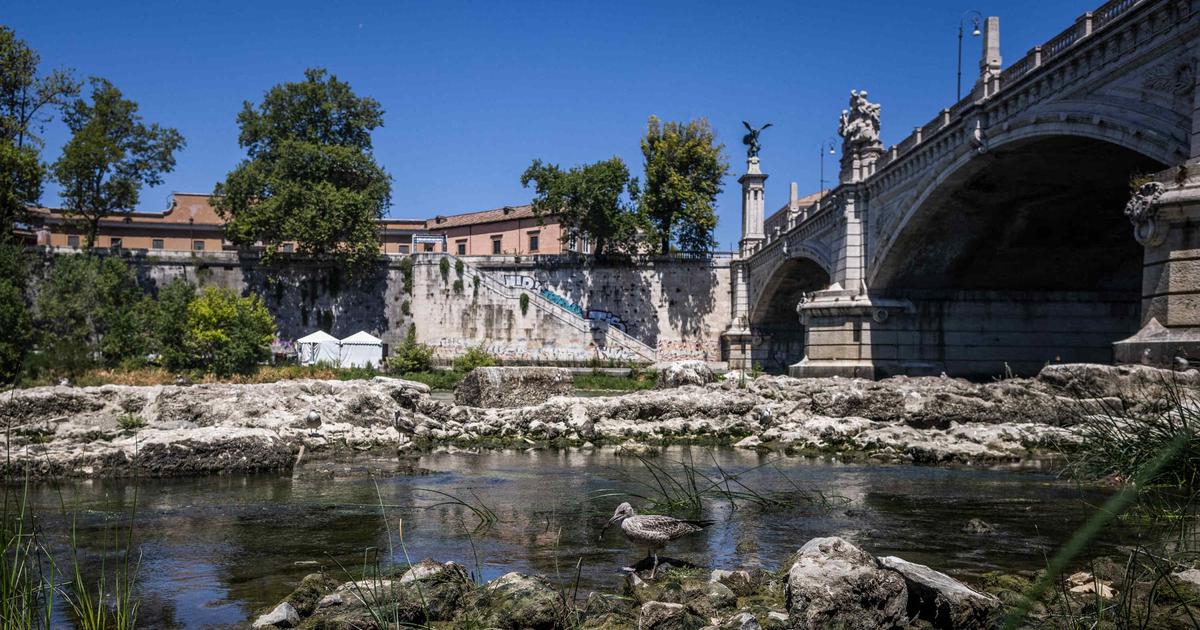The episode of heat in Italy draws from the palimpsest of Rome a new page emerging from its ancient chapters.
At the foot of the Vittorio Emanuele II bridge, in the heart of the capital, a stone snake has slowly emerged since the end of June from the olive waters of the Tiber.
The silhouette of hewn blocks betrays the archaeological nature of this limestone flap.
It was the Pons Neronianus, an ancient Roman bridge.
The appearance of these remains appreciated by birds is not uncommon in the Lazio summer.
The drought and leaden weather that have been hitting Italy for more than a month have, however, tested the waters of the Tiber, the level of which has decreased by about one and a half meters compared to its summer average, thus revealing these ruins.
Like the Zouave on the Alma bridge in Paris, this ancient tongue of stone presides over the changing vigor of the river.
Romans and Romans, skillful or passing through, experience the burning sun and the spectacle of these ruins together.
Read alsoAt the Baths of Caracalla, a luxurious residence and its frescoes find the crowds of Rome
The eloquence of the site bearing the name of the Roman emperor Nero, in power between 54 and 68, particularly caught the attention of Igor Boni, the president of the micro social-liberal party Radicali Italiani, which organized the July 1 a press conference on the banks of a shrunken Tiber.
"In Rome, to date, 140 mm of rain has fallen against 430 mm on average: these are figures from countries like Algeria and Tunisia
," warned the politician close to the remains of the Pons Neronianus.
Discarded bicycles and abandoned electric scooters offered their soiled bodies on the surface of the diminished waters of the Tiber in mid-July, forming nesting perches more modern than the Roman bridge.
A bridge between two eras
This half-emerged ancient structure testifies not only to the level of the Tiber or the harshness of the drought, but also to a small lapse in judgment of the Roman engineers of the 1st century.
Civil engineering would have chosen the location of the bridge very badly, the remaining vestiges of which correspond to the remains of pillars.
"It was built on a sharp bend in a floodplain
," archaeologist Rabun Taylor (University of Texas at Austin) told American media LiveScience.
The Pons Neronianus is located in the most salient bend of the Tiber, in the center of Rome, close to Castel Sant'Angelo.
A choice that puts a strain on bridge abutments and can cause a collapse.
Read alsoIn the mountains of Albania treasure looters are wreaking havoc
"That's probably what happened to Nero's Bridge, and it may well have happened in the mid-200s AD, less than two centuries after his death
," Rabun Taylor said.
Despite its nickname, the structure - which is not mentioned by ancient sources - however, would not be linked with certainty to Nero and could have been erected under his predecessor, Caligula.
Several pillars preserved up to about a meter above the surface of the Tiber were razed at the end of the 19th century to make this sector of the river better navigable, reports the museum of Castel Sant'Angelo in a press release.
River navigation was also disrupted on parts of the Po in northern Italy.
The region is particularly afflicted by the drought that is raging in the rest of the country.
This heat wave has already unearthed more contemporary remains, such as the wrecks of ships sunk during the Second World War.
According to the Italian agricultural union Coldiretti, the drought threatens more than 30% of national agricultural production.

